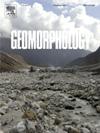Evolution of the proto-Weihe River system during the Eocene–Oligocene: Evidence from sediment provenance of the Weihe Basin
IF 3.1
2区 地球科学
Q2 GEOGRAPHY, PHYSICAL
引用次数: 0
Abstract
The Weihe River, originating from the northeastern Tibetan Plateau, is one of the most important tributaries of the Yellow River. The Cenozoic evolution of the Weihe River provides critical insights into the geomorphologic uplift of the northeastern Tibetan Plateau, and the drainage evolution of the Yellow River. However, the Paleogene evolution of the Weihe River remains poorly understood. The Weihe Basin, located adjacent to the northeast of the Tibetan Plateau and at the lower reaches of the Weihe River, preserved continuous sediments record spanning from the middle Eocene to the Oligocene. Source to sink analysis offers valuable evidence for deciphering regional drainage evolution. This study investigates the sediment provenance of the Eocene-Oligocene sedimentary strata in the Weihe Basin and its temporal variations, employing detrital zircon U![]() Pb dating on 19 new samples alongside sedimentary analyses. We find that the regional river drainage underwent two evolutionary of stages during this period. During the Eocene (ca. 46–34 Ma), the Weihe Basin was characterized by a shallow lacustrine environment, receiving clastic materials primarily from the surrounding areas. By the early Oligocene (ca. 34–31.7 Ma), contributions from the modern upper reaches of the Weihe River increased. This suggested that the proto-Weihe River system began to form during the Oligocene, exhibiting a pattern that closely resembles its modern configuration. This drainage evolution was mainly controlled by tectonic deformation of the northeastern Tibetan Plateau, and enhancement in headwards erosion due to increased precipitation.
Pb dating on 19 new samples alongside sedimentary analyses. We find that the regional river drainage underwent two evolutionary of stages during this period. During the Eocene (ca. 46–34 Ma), the Weihe Basin was characterized by a shallow lacustrine environment, receiving clastic materials primarily from the surrounding areas. By the early Oligocene (ca. 34–31.7 Ma), contributions from the modern upper reaches of the Weihe River increased. This suggested that the proto-Weihe River system began to form during the Oligocene, exhibiting a pattern that closely resembles its modern configuration. This drainage evolution was mainly controlled by tectonic deformation of the northeastern Tibetan Plateau, and enhancement in headwards erosion due to increased precipitation.
求助全文
约1分钟内获得全文
求助全文
来源期刊

Geomorphology
地学-地球科学综合
CiteScore
8.00
自引率
10.30%
发文量
309
审稿时长
3.4 months
期刊介绍:
Our journal''s scope includes geomorphic themes of: tectonics and regional structure; glacial processes and landforms; fluvial sequences, Quaternary environmental change and dating; fluvial processes and landforms; mass movement, slopes and periglacial processes; hillslopes and soil erosion; weathering, karst and soils; aeolian processes and landforms, coastal dunes and arid environments; coastal and marine processes, estuaries and lakes; modelling, theoretical and quantitative geomorphology; DEM, GIS and remote sensing methods and applications; hazards, applied and planetary geomorphology; and volcanics.
 求助内容:
求助内容: 应助结果提醒方式:
应助结果提醒方式:


